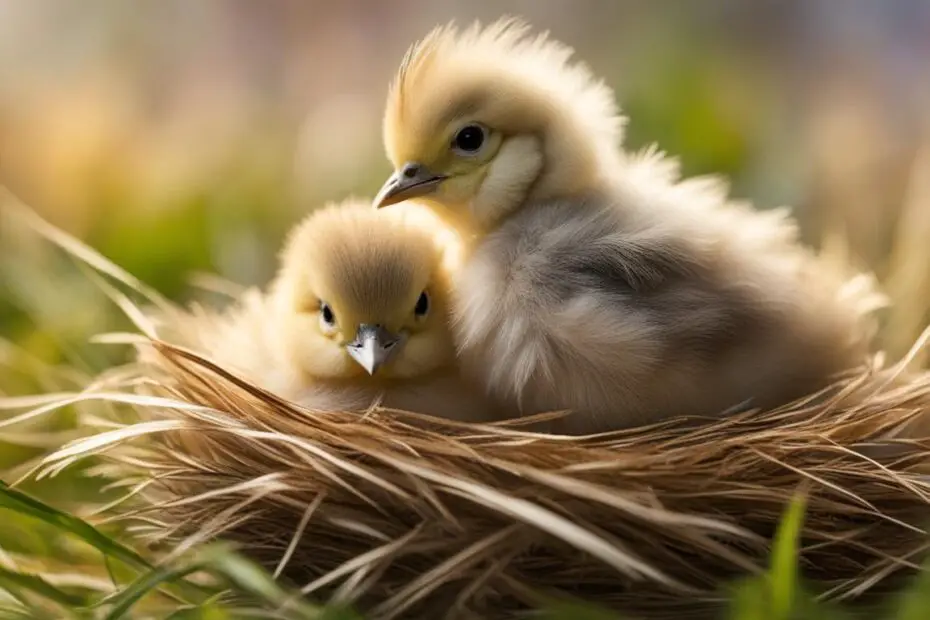Curious about the appearance and characteristics of fully feathered chicks? Understanding the different stages of chick feather growth and development can provide valuable insights into the maturation process. From the initial emergence of pinfeathers to the development of contour feathers, fully feathered chicks undergo a remarkable transformation. Let’s explore the visual features and feather patterns in mature chicks.
Detailed Notes: During the first stage, known as “pinfeathers,” the chick begins to grow its first feathers. These feathers are short, stiff, and sharp, and they provide little insulation or protection. As the chick grows older, its pinfeathers will be replaced by softer down feathers. The second stage of feathering occurs when the down feathers are replaced by “covert” feathers. These feathers are larger and more protective than down feathers, but they’re still relatively soft and flexible. The covert feathers help to keep the chick warm and dry, and they provide some protection from predators. Finally, the third stage of feathering sees the development of “contour” feathers. These are the long, stiff feathers that cover the chick’s body and give it its distinctive shape. The contour feathers provide excellent insulation and allow the chick to fly. By the time a chick has fully feathered out, it will look very different from the tiny hatchling that emerged from its egg just a few weeks earlier.
The Appearance of Fully Feathered Chicks
When a chick is newly hatched, it is covered in down. This fuzzy coat will keep the chick warm and help protect it from the elements. The chicks’ eyes are closed, and they are unable to walk or stand up on their own. Baby chicks rely on their parents to keep them warm and safe until they are able to do so themselves. In the first few days after hatching, baby chicks will drink a lot of water and eat a lot of food. They will also start to grow feathers which will help keep them warm. By about two weeks old, baby chicks should be able to walk and run around on their own. They will continue growing feathers until they are fully feathered at about four weeks old. At this point, they can be safely moved outside into a coop with other chickens.
Key Takeaways:
- Fully feathered chicks go through different stages of feather growth and development.
- Pinfeathers are the first feathers that emerge and provide little insulation or protection.
- Covert feathers replace down feathers and offer more protection from the elements.
- Contour feathers are the long, stiff feathers that cover the chick’s body and allow it to fly.
- Fully feathered chicks look very different from newborn hatchlings and are ready to join other chickens in a coop.
The Appearance of Fully Feathered Chicks
When fully feathered, chicks undergo a remarkable transformation from their initial downy state. At hatching, chicks are covered in soft down feathers that provide insulation and protection. Their eyes are closed, and they are dependent on their parents for warmth and safety. However, as they grow, their feather development progresses, and they become more independent.
After a few days, baby chicks start to grow feathers, which help regulate their body temperature. Over the course of about four weeks, the chick’s initial down feathers are replaced by more mature feathers. The final stage of feathering is the development of contour feathers, which cover the chick’s body and give it its distinctive shape. These long, stiff feathers provide excellent insulation and enable the chick to fly when it matures. By the time a chick is fully feathered, it undergoes a remarkable physical transformation and looks vastly different from its initial hatchling stage.
| Visual Feature | Description |
|---|---|
| Feather Coverage | Fully feathered chicks are covered in contour feathers that provide insulation and enable flight. |
| Distinctive Shape | The contour feathers give the chicks their characteristic shape, with a streamlined body and defined wings. |
| Coloration | Fully feathered chicks’ coloration varies depending on the breed, with a wide range of patterns and hues. |
| Independence | Fully feathered chicks are capable of walking and running on their own, no longer requiring constant parental care. |
The visual characteristics of fully feathered chicks are truly remarkable, and they signify the chicks’ readiness to transition from the brooder to a coop with other chickens. It is important to ensure that chicks are fully feathered before moving them to the coop, as their feathers provide protection against the elements and predators.
The Feathering Process in Chicks
As baby chicks grow, they go through different stages of feather development, which contribute to their overall growth and ability to adapt to their environment. Understanding the feather growth stages in chicks is essential for poultry owners to ensure proper care and management. Let’s take a closer look at the key stages of chick feathering:
Stage 1: Pinfeathers
During the first stage, known as pinfeathers, the chick begins to grow its initial feathers. These feathers are short, stiff, and provide minimal insulation or protection. As the chick matures, these pinfeathers will be replaced by softer down feathers.
Stage 2: Down Feathers
In the second stage, down feathers replace the pinfeathers. These feathers are larger and more protective than pinfeathers, providing warmth and some defense against predators. Down feathers are relatively soft and flexible, allowing the chick to move comfortably.
Stage 3: Contour Feathers
The final stage of feathering is the development of contour feathers. These are the long, stiff feathers that cover the chick’s body and give it its distinctive shape. Contour feathers provide excellent insulation and enable the chick to fly once fully grown.
As baby chicks grow older, they gradually lose their down feathers and replace them with adult feathers. This feather development process is essential for their mobility, thermoregulation, and overall well-being.
Feather Growth and Maturation in Chicks
As baby chicks grow older, their down feathers are replaced with adult feathers in a maturation process that takes several weeks. Understanding the stages of feather growth in chicks is crucial for ensuring their health and well-being. Chickens’ feathers consist of different types, including filoplumes, down feathers, and contour feathers.
Table: Types of Chicken Feathers
| Type of Feather | Description |
|---|---|
| Filoplumes | Thin, thread-like feathers that contribute to feather development and temperature regulation. |
| Down Feathers | Soft and fluffy feathers that provide insulation for baby chicks. |
| Contour Feathers | Long, stiff feathers that give chickens their distinct shape and allow them to fly. |
The maturation of chick feathers begins with the growth of down feathers, which provide warmth and protection. As the chicks grow older, they gradually lose their down feathers and replace them with adult feathers. This molting process typically occurs around two months of age. By three to four months, the chicks will have fully developed adult feathers.
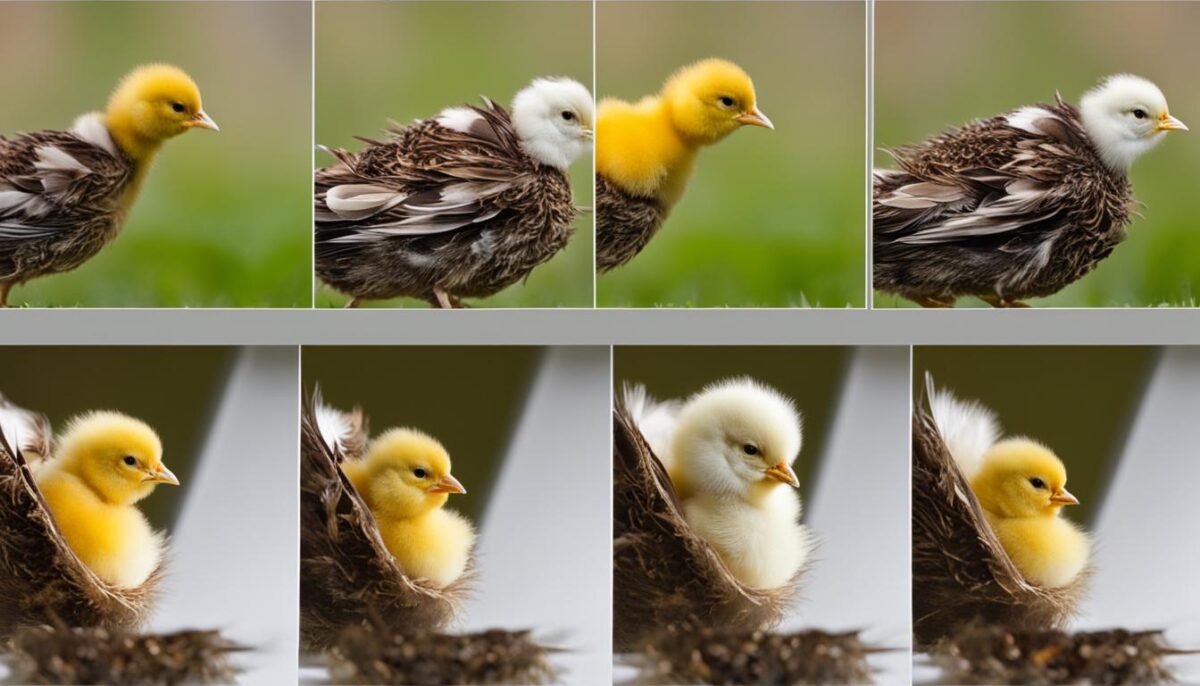
The Role of Feathers in Chickens
Feathers play a crucial role in the life of chickens, serving multiple functions and contributing to their overall well-being. Here are some of the key purposes and functions of chicken feathers:
- Insulation: One of the primary functions of feathers is to provide insulation for chickens. Feathers help to regulate body temperature by trapping air close to the chicken’s skin, creating a layer of warmth. This insulation is particularly important during cold weather, protecting chickens from low temperatures and preventing heat loss.
- Flight: Feathers enable chickens to fly, although not all chicken breeds are capable of sustained flight. Contour feathers, which are long and stiff, provide the necessary lift and support for chickens to take flight, allowing them to escape predators or explore their surroundings.
- Protection: Feathers act as a protective barrier for chickens against external elements and potential threats. The dense arrangement of feathers helps shield chickens from rain, snow, and wind, keeping them dry and reducing heat loss. Additionally, feathers can provide some defense against predators by making chickens appear larger and less vulnerable.
- Communication: Feathers are also integral to communication among chickens. Certain feather displays, such as raising hackles or fluffing feathers, can convey important social cues and indicate the chicken’s mood or dominance status within the flock. Feathers can play a role in establishing hierarchy, attracting mates during courtship, and expressing aggression or submission.
Understanding the purpose and functions of chicken feathers is essential for providing appropriate care and ensuring the well-being of these feathered creatures. From insulation and flight to protection and communication, feathers are a remarkable adaptation that contributes to the survival and behavior of chickens.
Factors to Consider When Moving Chicks to the Coop
When it comes to moving chicks to the coop, there are several factors to consider. The timing of this move depends on the chicks’ age, feathering development, and external temperatures. In general, most chicks are fully feathered by around six weeks of age and can be safely moved to the coop if the weather is warm enough.
One important consideration is the brooder temperature. As the chicks grow older and become fully feathered, the brooder temperature should be gradually reduced. This helps the chicks acclimate to the cooler conditions they will experience in the coop. It’s recommended to decrease the brooder temperature by 5 degrees each week until the chicks are ready to be moved.
Before moving the chicks, it’s important to ensure that the coop is predator-proof. This means securing any openings or weak points that could allow predators to access the coop. Additionally, if you have an existing flock of older chickens, it’s crucial to integrate the chicks slowly and carefully to prevent any aggression or bullying.
Lastly, moving chicks to the coop can be a stressful process for them. Giving them time to acclimate and establish the coop as their permanent home is essential. Provide them with food and water in the coop, and monitor their behavior to ensure they are adjusting well to their new environment.
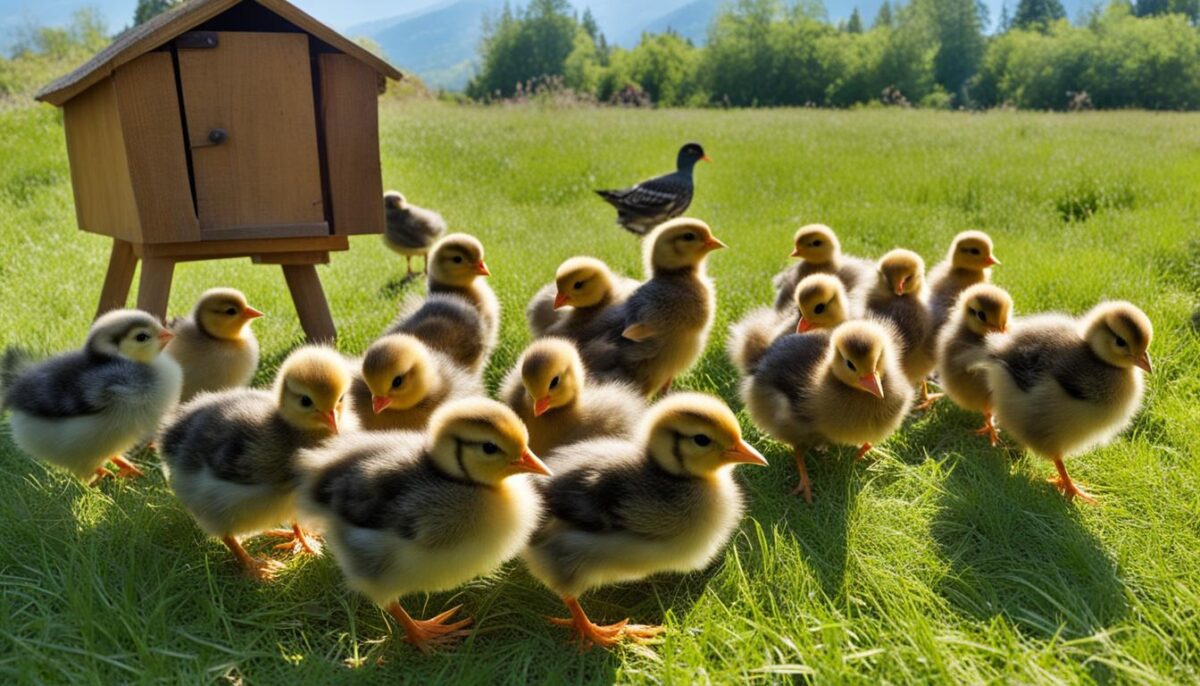
Table: Temperature Guidelines for Moving Chicks to the Coop
| Age of Chicks | Temperature | Behavioral Cues |
|---|---|---|
| 1-2 weeks | 95-100°F | Huddling near heat source |
| 3-4 weeks | 85-90°F | Sleeping further away from heat source |
| 5-6 weeks | 75-80°F | Comfortable away from heat source |
| 6+ weeks | Above 65°F | Ready to be moved to the coop |
Table: Temperature guidelines for moving chicks to the coop. These temperature ranges provide general guidance, but it’s important to monitor the chicks’ behavior and adjust accordingly. If the chicks are huddled too closely to the heat source, it may indicate that the temperature is too cold for them, and adjustments should be made.
Maintaining Optimal Temperature for Chicks
For the health and well-being of chicks, it is crucial to maintain an optimal temperature in their brooder. Chicks require a constant source of heat until they are fully feathered and able to regulate their body temperatures. The brooder temperature should be around 100 degrees Fahrenheit for day-old chicks and gradually reduced by 5 degrees each week as they grow older. However, it is important to note that temperature guidelines should be adjusted based on the chicks’ behavior and comfort level.
Observing their behavior can help determine if the temperature is too hot or too cold. If the chicks huddle near the heat source or appear lethargic, it may indicate that the brooder is too cold. On the other hand, if the chicks move away from the heat source or pant excessively, it may indicate that the brooder is too hot. Adjusting the temperature accordingly will help ensure that the chicks are comfortable and thriving.
Once the chicks are fully feathered and at least six weeks old, they can be moved to the coop if the outdoor temperatures are above 65 degrees Fahrenheit. At this point, the chicks should be able to regulate their body temperature without the need for a heat source. It is important to monitor the outside temperatures and ensure that they are suitable for the chicks before moving them to the coop.
To summarize, maintaining the optimal temperature for chicks is essential for their growth and development. By providing them with the right amount of heat in the brooder and monitoring their behavior, we can ensure their comfort and well-being. As they grow older and become fully feathered, they can gradually acclimate to the outside temperatures and transition to the coop without the need for additional heat sources.
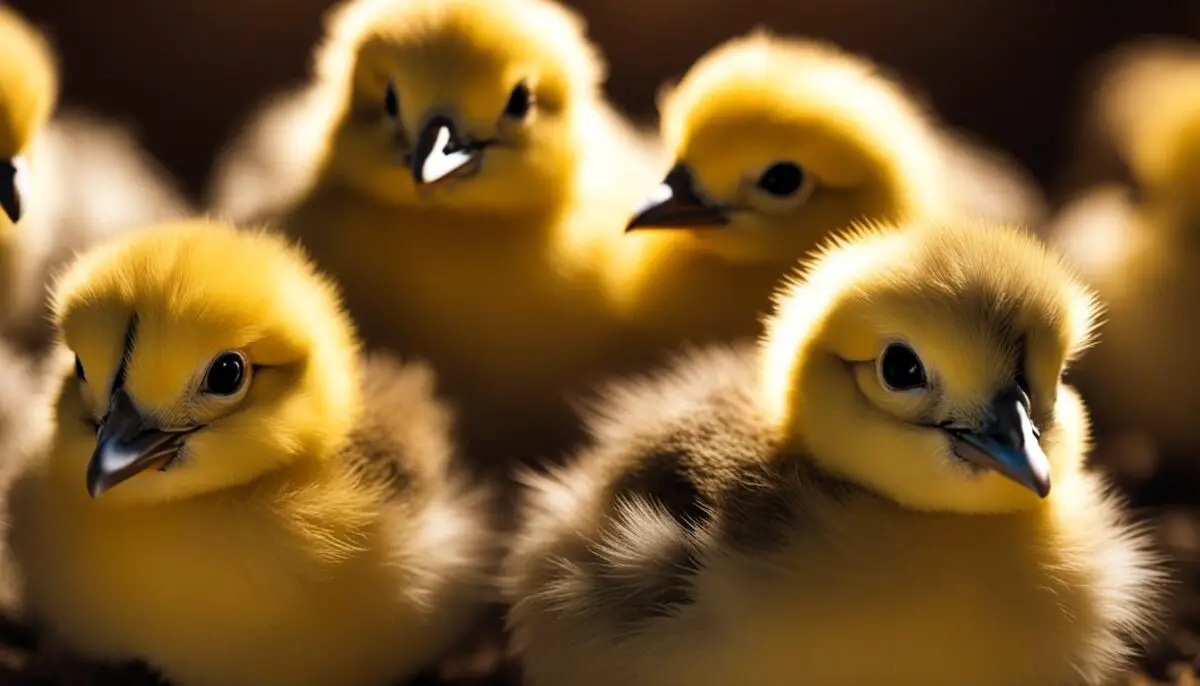
Essential Care and Feeding for Chicks
Proper care and feeding are crucial for the health and well-being of baby chicks. Here are some important considerations:
- Feeding: Baby chicks require a specialized chick starter feed that is high in protein, usually around 20%. This feed provides the essential nutrients they need for healthy growth and development. It’s important to offer the feed on an ad libitum basis, allowing the chicks to eat as much as they need.
- Water: Clean water is essential for chicks, and it should be provided in specialized chick waterers. Ensure that the water is fresh and easily accessible to the chicks at all times.
- Feeders: Using proper chick feeders is important to prevent waste and contamination. Choose feeders that are suitable for their size and design, making it easy for the chicks to access the feed without making a mess.
- Health Supplements: Depending on the specific needs of your chicks, you may consider adding health supplements to their water. Chick vitamins and electrolytes can help support their overall well-being. Always follow the manufacturer’s instructions when using supplements.
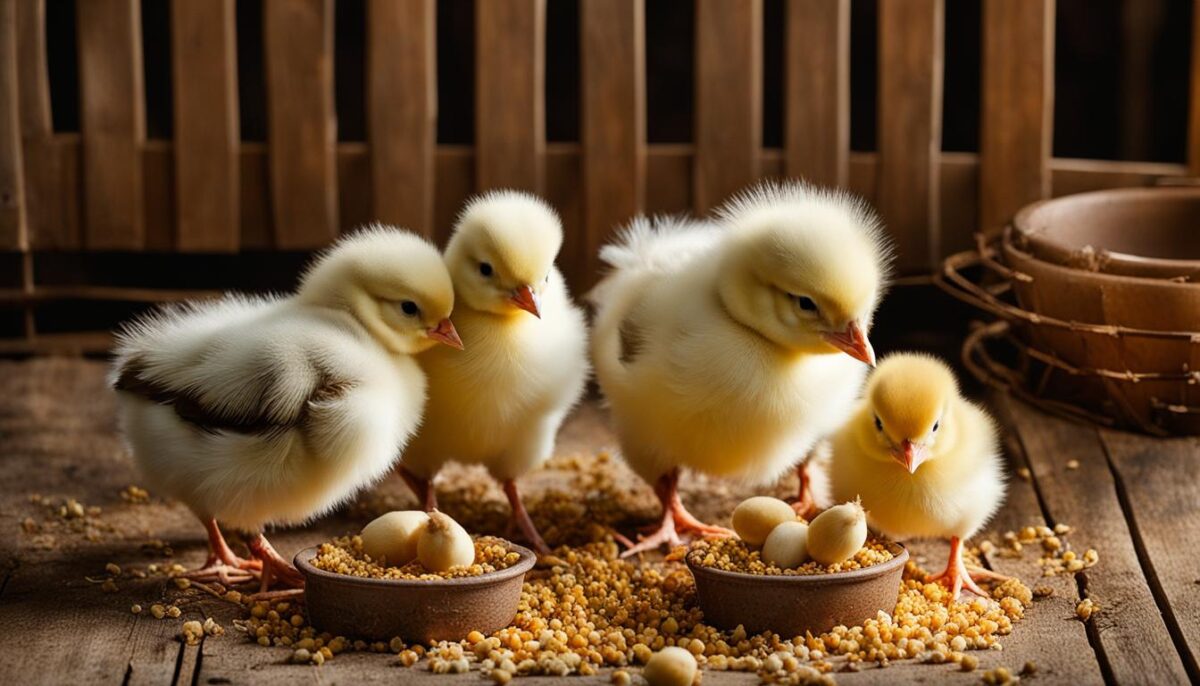
By providing the right feed, clean water, suitable feeders and waterers, and potential health supplements, you can ensure that your baby chicks receive the essential care they need to grow into healthy adult chickens.
Caring for Baby Chicks
Alongside their diet, there are other aspects of care to consider when raising baby chicks:
- Brooder Setup: A brooder is essential for keeping the chicks warm and safe during their early weeks. Maintain a suitable brooder temperature around 100 degrees Fahrenheit for day-old chicks, gradually reducing it by 5 degrees each week until they are fully feathered.
- Space: Provide adequate space for the chicks to move around, but avoid overcrowding. The general rule of thumb is to allow approximately 0.5 square feet per chick in the brooder.
- Cleanliness: Regularly clean the brooder to maintain a hygienic environment for the chicks. Remove any soiled bedding, replace it with fresh material, and ensure good ventilation.
- Handling: Handle the chicks gently and minimize stress. Avoid excessive handling in the early days, as they are vulnerable and delicate.
Remember, raising baby chicks requires attentive care and dedication. Providing them with appropriate feed, clean water, a suitable brooder setup, and gentle handling is essential for their healthy development.
Summary
Feeding and caring for baby chicks is a critical aspect of raising healthy, happy chickens. Providing a specialized chick starter feed high in protein, clean water in suitable feeders and waterers, and potential health supplements will ensure their nutritional needs are met. Additionally, creating a suitable brooder setup with a regulated temperature, adequate space, and good hygiene will contribute to their overall well-being. By following these essential care guidelines, you can support the growth and development of your baby chicks, setting them up for a thriving future as adult chickens.
Conclusion
Fully feathered chicks go through a natural growth process, transitioning from down feathers to adult feathers. Feathers are essential for providing insulation, enabling flight, and facilitating communication among chickens. Understanding the development and characteristics of fully feathered chicks is crucial for successfully raising healthy and happy chickens.
Moving chicks to the coop should be done once they are fully feathered and have acclimated to their environment. It’s important to consider their age, feathering development, and external temperatures before making the move. Additionally, providing a predator-proof coop and integrating them with older flock members should be taken into account to ensure a smooth transition.
Maintaining an optimal temperature is vital for the well-being of chicks. Gradually reducing the brooder temperature as they grow older and observing their behavior will help determine if the temperature is suitable. Once the chicks are at least six weeks old and the outdoor temperatures are above 65 degrees Fahrenheit, they should no longer require a heat source when moved to the coop.
Proper care and feeding are essential for the health of chicks. Offering a specialized chick starter feed that is high in protein, providing clean water and specialized feeders, and offering treats and supplements as needed will support their overall well-being. By following these guidelines and understanding the development of fully feathered chicks, you can ensure that your chicks thrive and grow into happy and healthy adult chickens.
FAQ
What are the different stages of feathering in chicks?
The different stages of feathering in chicks are pinfeathers, covert feathers, and contour feathers.
What is the purpose of down feathers in baby chicks?
Down feathers provide insulation and help keep baby chicks warm.
How long does it take for baby chicks to become fully feathered?
Baby chicks are usually fully feathered at around four weeks old.
What are the types of feathers in chickens?
The types of feathers in chickens are filoplumes, down feathers, and contour feathers.
What are feathers used for in chickens?
Feathers in chickens are used for insulation, flight, protection, and communication.
When should chicks be moved to the coop?
Chicks can be moved to the coop when they are fully feathered and the weather is suitable.
How should brooder temperature be managed for chicks?
The brooder temperature should be gradually reduced as the chicks grow older.
What should baby chicks be fed?
Baby chicks should be fed a specialized chick starter feed that is high in protein.
How long should chicks require a heat source?
Chicks require a heat source until they are fully feathered and able to regulate their body temperature.
Do baby chicks require any supplements?
Baby chicks may benefit from health supplements such as chick vitamins and electrolytes.


